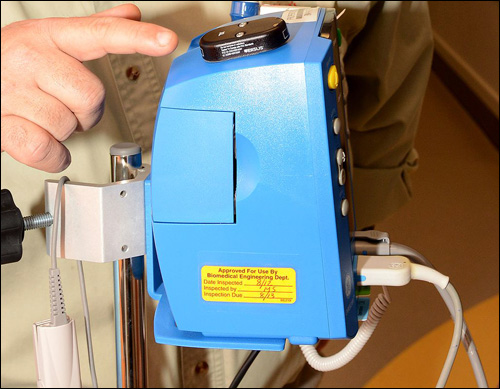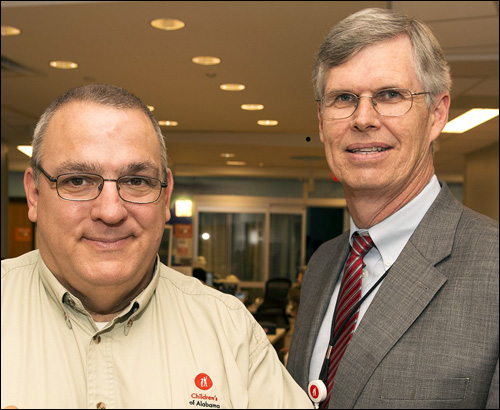When Children’s of Alabama, in Birmingham, began constructing its new 760,000-square-foot Benjamin Russell Hospital for Children, it strategized which type of technology could make the facility and its staff more efficient. Management met with biomedical, nursing and transportation employees, and found that tracking assets was a major priority. The hospital, however, also wanted infrastructure in place that would enable it to track personnel and patients, as well as hand-hygiene practices, in the future.
To accomplish this goal, the hospital worked with systems integrator VT Group Healthcare to install a Versus real-time location system (RTLS), used in conjunction with Four Rivers Software Systems‘ Total Maintenance System (TMS).

Since opening Benjamin Russell Hospital in August 2012, Children’s of Alabama is now expanding its use of the RTLS solution to its older building adjoining the new facility, floor by floor, as renovation is conducted.
Initially, the RTLS is being utilized only for tracking assets, according to Jack Storey, the chief information officer at Children’s of Alabama. The hospital has 13,000 pieces of mobile high-value medical equipment, and to date has tagged 1,700 of them—mostly ventilators, defibrillators, beds, IV pumps and stretchers. The hospital’s priority was to make it easy for the new facility’s staff to locate equipment when required for patients, as well as for maintenance and cleaning. Beds, for example, vary in size and style, based on a particular patient’s needs and size. Therefore, simply finding the appropriate bed can be a time-consuming task for staff members, according to Jason Head, Children’s of Alabama’s biomedical engineering supervisor and certified biomedical equipment technician.
In addition, the biomedical department conducts monthly maintenance on its equipment, and personnel must search for each item in order to get the work done. Not only can some assets take days to locate, but some are never found and end up missing the maintenance schedule entirely.
The hospital uses the TMS software to help its biomedical staff determine which items require servicing. The Versus RTLS solution is now integrated with that system, so that when workers review which items require maintenance, they can also be directed to the number of the room in which each asset is located.
Children’s of Alabama is attaching Versus VER-1832 tags to its assets, each containing a battery, an RFID transponder and an infrared beacon. Each tag is typically installed so that it has a clear line of sight with infrared (IR) receivers mounted on walls throughout the hospital. The tag transmits IR and RF signals, each encoded with the tag’s unique ID number, at regular intervals. The hospital has installed a total of 200 VER-4452 RFID readers and 1,100 VER-4432 IR receivers. When an IR receiver captures the ID of a tag within its vicinity, it forwards that information to the Versus Advantages Asset Tracking software, which links data related to that tag—such as the specific asset to which it is attached—to the location data, based on the specific IR sensor involved. The tag’s RF transmission is also received by RFID readers, which, in turn, send the transmission data to the back-end server.

The IR sensor data can pinpoint the tag’s location to within a particular room, while the RFID sensors can enable the software to determine an item’s location to within about 60 feet. In that way, the hospital explains, the RFID technology acts as a redundancy system, and can read a tag even if something is blocking the tag’s IR transmission, thereby rendering the IR portion of the system temporarily inoperable. In the event that a tag’s IR transmission is obstructed, the software calculates location based on the 60-foot radius of the RFID read, as well as the last time that an IR receiver picked up its signal.
Since being taken live at the time of Benjamin Russell Hospital’s opening, the system has made the biomedical maintenance of assets much more efficient, Head reports. The department uses tablet computers to view the locations of all equipment required for maintenance on a particular day. The transportation department also utilizes tablet computers upon receiving a request for a wheelchair, bed or stretcher. The transportation employee can then use the tablet to view the requested asset’s location in the Versus software, and direct a staff member to retrieve that item, thereby saving time that would otherwise have been spent walking the halls searching for it.
Eventually, Children’s of Alabama plans to employ the Versus RTLS solution to track when nurses respond to emergency calls or visit patients. The hospital uses Ascom‘s Telligence nurse-call system to alert nurses when they are needed by a patient in a specific location. Once the hospital begins utilizing the Versus system with the Telligence platform, nurses would wear a Versus IR-RFID badge that would beacon as its wearer moved around the facility. When a nurse enters within range of the IR sensor installed at the room of the specific patient who issued the call, the software would know that someone had responded to the call and could store that data, in addition to stopping the alert messaging to the nursing staff. In the future, that technology could also be used to create a record of how often and for how long patients received visits from personnel—data which could then be presented to patients’ loved ones if so requested.
In the long term, Storey says, Children’s of Alabama also hopes to provide RTLS tags to all patients and workers, in order to track the movements of people throughout the facility. This, the hospital notes, would make patient care more efficient, and enable the facility to identify bottlenecks or areas in need of improvement, based on the amount of time patients may await service, or that employees are delayed in performing specific tasks, based on their location data.
For Children’s of Alabama, one advantage of installing the software and sensor infrastructure at the time that its new facility was built is the ease with which the hospital can now expand the system, simply by applying additional tags to assets, or by providing tags to patients and staff members. If greater coverage becomes necessary, Storey notes, the hospital can simply install additional sensors.
Eventually, the hospital indicates, the asset-tracking system will be installed within the six in-patient facilities comprising the Children of Alabama’s main campus. However, the exact dates for deployment have yet to be determined.
The hospital also hopes to use the technology to monitor when personnel wash or sanitize their hands while working. This week, Georgia-Pacific Professional teamed up with Versus to provide a hand-hygiene solution known as SafeHaven, consisting of Georgia-Pacific Professional skin-care products used in dispensers utilizing Versus RTLS readers to enable customers to track the hand-washing behavior of individuals wearing the RTLS badges.

